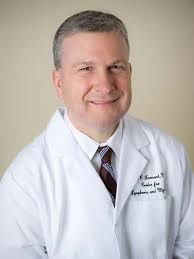Tazemetostat Approval Addresses Unmet Need in Relapsed/Refractory Follicular Lymphoma
In an interview with Targeted Oncology, John P. Leonard, MD, discussed the results of the phase 2 study of tazemetostat, the drug approval for relapsed/refractory follicular lymphoma, and the role of tazemetostat in the community setting.

Findings from a phase 2 study (NCT01897571) of tazemetostat in patients with advanced solid tumor and B-cell lymphomas led to the FDA approval of tazemetostat as treatment of patients with relapsed or refractory follicular lymphoma (FL) who tumor harbor an EZH2 mutation, as detected by an FDA approved tested, and who had had a minimum of 2 prior lines of systemic treatment.
In the study, treatment with tazemetostat achieved an objective response rate (ORR) of 69% in patients with FL harboring an EZH2 mutation and an ORR of 35% among patients with EZH2 wild-type disease. The median duration of response (DOR) was 10.9 months. Also, the median progression-free survival observed with the agent was 11.1 months.
The safety profile presented in this study was favorable and tolerable. In terms of grade 3 or higher treatment-related adverse events, the most common were thrombocytopenia (3%), anemia (2%), asthenia (1%), and fatigue (1%), and these events led to few treatment discontinuations.
Looking at the treatment landscape for relapsed/refractory FL, John P. Leonard, MD, said these results are “meaningful” because they offer another option for patients after the watch and wait period and an alternative to chemotherapy, monoclonal antibodies, immunomodulatory agents, and PI3 kinase (PI3K) inhibitors. The drug also has potential for addressing the indolent nature of FL, which often requires multiple different treatment over the years.
In an interview with Targeted Oncology, Leonard, the Richard T. Silver Distinguished Professor of Hematology and Medical Oncology at Weill Cornell Medicine, an oncologist at NewYork-Presbyterian/Weill Cornell Medical Center, discussed the results of the phase 2 study of tazemetostat, the drug approval for relapsed/refractory FL, and the role of tazemetostat in the community setting.
TARGETED ONCOLOGY: Can you begin with explaining what prognoses are generally like for patients with FL?
Leonard: It's the most common of the indolent or low-grade type of lymphomas. Many people with FL don't need treatment. At diagnosis, we will watch and wait, but most people eventually need treatment. Most people eventually get a series of treatments over many years. The majority of people with FL don't die from it, they die with it. It is something that tends to be managed long term.
Over time, many patients also need to have additional therapies besides chemotherapy and some of the other previously available treatments. Having a new option is something that, for some patients, will be quite meaningful.
TARGETED ONCOLOGY: Can you discuss the uniqueness of tazemetostat and how it differs from similar inhibitors?
Leonard: Tazemetostat is an inhibitor of EZH2, and in that case, it is epigenetic modifier, which is a different target then the currently available treatments for lymphoma. The current treatments are either chemotherapy; monoclonal antibodies like rituximab (Rituxan) or lenalidomide (Revlimid), which is an immunomodulatory drug; or PI3K inhibitors. The drug also has a good safety profile and has shown activity in patients with relapsed/refractory FL, whether or not they have an EZH2 mutation. The majority of patients with FL do not have an EZH2 mutation, but in that subgroup of patients, this medicine has about a 70% response rate, whereas in patients that are wild type or do not have a mutation, the drug has about a 33% response rate. It’s lower, but in my view, it is still meaningful.
TARGETED ONCOLOGY: What were the key goals for the phase 2 study?
Leonard: The goals for the phase 2 study were to treat a cohort of patients with follicular lymphoma, who received previous treatment and to see the efficacy and safety tazemetostatin this population. There were 2 cohorts. One had an EZH2 mutation and the other had EZH2 wild type, and the study went on to show the efficacy and safety of those 2 cohorts.
TARGETED ONCOLOGY: What was most exciting about the data that led to the accelerated FDA approval?
Leonard: In EZH2-mutant patients with a response rate of 69% and DOR of almost 11 months, and who had multiple prior therapies, I think that is meaningful. In the wild-type patients, the efficacy was lower but nonetheless meaningful for some patients, depending on what options they have based on the practice they’re treated in.
TARGETED ONCOLOGY: How significant will this agent be for oncologists and the community setting and their patients?
Leonard: As of now it is an agent that I think will be a significant an option for patients with relapse and refractory FL. It depends on their setting, whether or not they have a mutation, what other options are available, and what their preferences are.
I think in the future will see additional studies there will combine tazemetostatwith other agents, and depending on the results of those studies, it may be an agent that's used potentially earlier in the course of the disease in combination of those agents.
Examining the Non-Hodgkin Lymphoma Treatment Paradigm
July 15th 2022In season 3, episode 6 of Targeted Talks, Yazan Samhouri, MD, discusses the exciting new agents for the treatment of non-Hodgkin lymphoma, the clinical trials that support their use, and hopes for the future of treatment.
Listen
Does Odronextamab Show Hope in FL and DLBCL Despite Regulatory Hurdles?
November 5th 2024Despite regulatory challenges from the FDA, odronextamab has received European approval for the treatment of patients with relapsed/refractory follicular lymphoma or diffuse large B-cell lymphoma following 2 prior treatments.
Read More